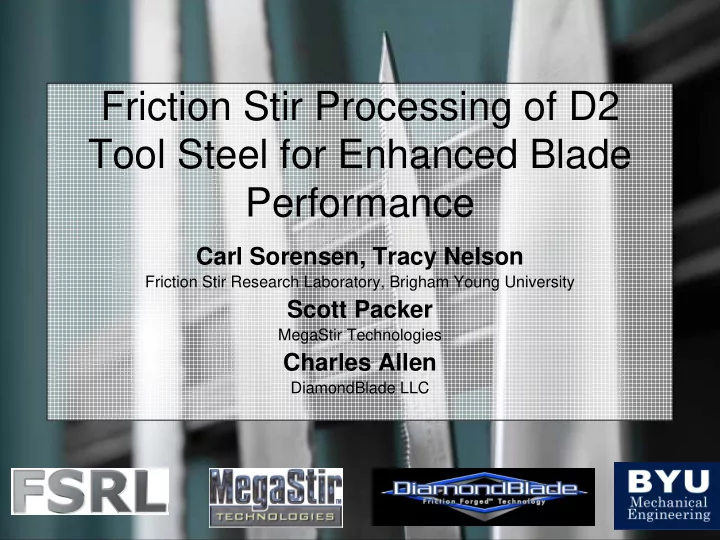

Friction Stir Processing of D2 Tool Steel for Enhanced Blade Performance Carl Sorensen, Tracy Nelson Friction Stir Research Laboratory, Brigham Young University Scott Packer MegaStir Technologies Charles Allen DiamondBlade LLC
Key Points • Background – FSP Technology – FSP for Microstructural modification – FSP for Property Modification – Knife Sharpness Testing – D2 Steel • Experimental Methods • Microstructure Results • Knife Performance Results • Qualitative Performance Tests
Friction Stir Processing a) Rotating nonconsumable FSP tool b) Initial pin entry creating frictional heating c) Shoulder contact creating a column of plasticized metal d) Local friction stir processing creating selective property improvements
FSP for Microstructural/ Property Modification • Thick-section superplasticity • NiAl Bronze propellers • Bending of high-strength Al alloys
Friction Stir Processing of 0.2" thick 7475 Al Sheet FSP Zone FSP Zone Selective FSP for local superplastic forming
Thick Section Superplasticity Conventional versus superplastic metal flow in 5mm thick 7050 aluminum Starting Sample Conventional Flow: severe necking Fine grain created via FSP Superplastic Flow: • Uniform strain >600% • Fracture strain >800%
Casting Modification • FSP of NiAl Bronze Castings for U.S. Navy Raw casting contains: • very large grain size, and • lots of porosity
Casting Modification • FSP NiAl Bronze Casting Yield strength Tensile strength 63ksi vs. 31ksi 108ksi vs. 65ksi As-Cast Microstructure FSP Microstructure
EFV application for FSP enhanced thick section bending EFV Turret Expeditionary Fighting Vehicle Welded thick Al plate construction potentially replaced via FSP bending Benefits: Improved properties and potentially lower cost
Bending of As-Cast and FSP 2519 Aluminum Bending performed at room temperature (20ºC) Fracture occurred at ~32° to 35 ° FSP raster depth 6.3mm 85° Bend Smooth surface with no indication of impending fracture
Thick section Bending • 152 mm FSP 6061 bent at room temperature – FSP bends 30º without failure – Parent fails at 7º
Sharpness Testing: CATRA Edge Retention Tester • Standard medium: card stock impregnated with silica • Constant cutting CATRA Cutting Test to ISO 8442.5 parameters 60 – Force perpendicular to Card cut/stroke mm(sharpness) 50 edge 40 – Cutting speed and stroke length 30 • Measure thickness of 20 media cut with each 10 stroke 0 0 50 100 150 200 250 300 350 Cumulative card cut mm (edge durability)
Sharp and Dull Edges
Sharpness Testing: CATRA Razor Edge Sharpness Tester • Controlled medium: extruded silicone similar to weather stripping • Press edge into medium with no motion parallel to edge • Measure peak force; low force implies high sharpness
D2 Steel • Air-hardenhable, high Cr cold-work tool steel • Cr and V for high hardenability • Significant wear resistance due to high carbide content • Not stainless due to Cr tied up in carbides C Cr Mn Si Ni Mo V 1.4- 11.0- 0.6 0.6 0.3 0.7- 1.1 1.6 13.0 max max max 1.2 max
Experimental Methods • Process straight D2 blades, with DOE controlling parameters • Transverse specimens for optical microscopy and microhardness testing • Blade edge cut with waterjet to avoid HAZ • CNC grinding of edge; final sharpening using fixture to control geometry • Use modified CATRA test with manila rope instead of CATRA media to wear blade • CATRA REST used to measure sharpness
Tool Geometry • PCBN tool, CS4 Shoulder geometry – Shoulder convex radius 3.5 in. (90 mm) • 0.140 in. (3.5 mm) thick sheet • 0.090 in. (2.2 mm) long pin – Partial penetration processing • 15 degree pin half angle • Step spiral or three flats on pin, depending on DOE
DOE Parameters Spindle Weld Side Next Speed, Feed, IPM Hardness Pin Blade IDs to Blade Edge RPM Retreating 300 3 40 Stepped Spiral 2-1, 2-2 Retreating 450 3 30 Stepped Spiral 4-1, 4-2 Advancing 300 5 30 Stepped Spiral 5-1, 5-2 Advancing 450 5 40 Stepped Spiral 7-1, 7-2 Advancing 300 3 30 Tri-flat 1-1, 1-2 Advancing 450 3 40 Tri-flat 3-1, 3-2 Retreating 300 5 40 Tri-flat 6-1, 6-2 Retreating 450 5 30 Tri-flat 8-1, 8-2
FF of D2 Knife Blanks
Processing
Metallography Large carbides reduced in size Small carbides smaller and more widespread Grain size reduced by order of magnitude 10 µ µm m 10 Base Metal 10 µ µm m 10 10 µ 10 µm m 250 RPM, 4 IPM 600 RPM, 4 IPM
Metallography (cont.) FSP D2 – 250 RPM, 4 IPM Sub-micron grain size; 200- 500 nm S30V Powder Metallurgy Alloy Fine grains of 2-5 µm 10x the size of FSP 10 µ m
ASTM Grain Size
Increased Cr in Processed Zone Macrograph shows no attack in processed zone with Nital Zone is stainless Higher Cr in solution increases strain energy and hardness Stainless prevents corrosion at the cutting edge to reduce sharpness; minimizes chemical wear Cr comes from dissolved and reduced size carbides
Microhardness of Processed Zone 1100 1000 900 Vickers Hardness, 500g 800 700 600 500 400 300 200 100 0 -15000 -10000 -5000 0 5000 10000 15000 Distance from Stir Zone Centerline, µ m Stir zone hardness of up to 1000 HV (equivalent to 67 RC)
Knife Performance – Modified ERT 0.5 Friction Forged Rope cut per Stroke in ERT tester, 0.45 REF D2 1-1 0.4 S30V S90V 0.35 0.3 in. 0.25 0.2 0.15 0.1 0.05 0 0 50 100 150 200 250 300 Total rope cut, in. Uses manila rope, instead of silica-impregnated paper
Performance – Rope Cut to Dull 300 Friction Forged REF D2 1-1 250 S30V Total rope cut, in S90V 200 150 100 50 0 0 1 2 3 4 5 Average REST value, N
Summary • FSP of D2 steel leads to increased performance of blade edges • FSP D2 is stainless due to increased Cr in matrix • Prior austenite grain size in FSP D2 is between 200 and 500 nm • Hardnesses up to 1000 HV are found in FSP zone • Blade has outstanding sharpness, toughness, and durability
Questions?
Recommend
More recommend